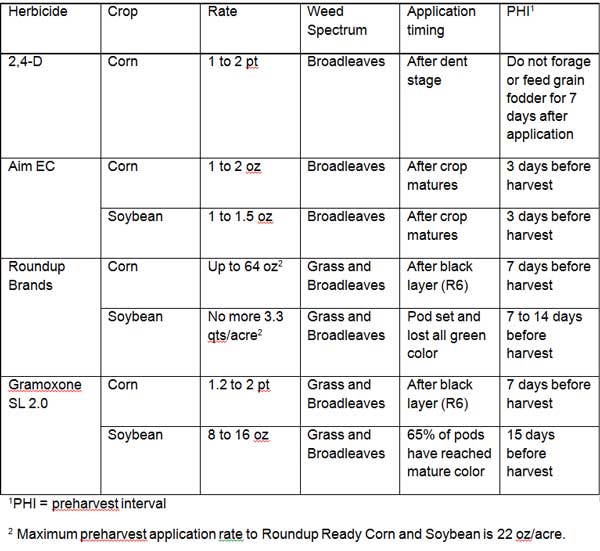- Pre-harvest herbicide applications can be used to improve harvest efficiency.
- Pre-harvest herbicide applications may also reduce weed seed production, depending on the species and stage of weed development.
- Significant yield losses can occur if label restrictions are not followed relative to crop growth stage.
- Be aware of and adhere to label guidance on pre-harvest interval.
A number of calls have come in asking for options to control various weeds before harvest. This is an acceptable practice, but care must be used to pick a product and rate that will effectively control the targeted weed species. It is also important to carefully consider the goal of this application. Is this application needed to increase harvest efficiency? Or, is this application needed to reduce the amount of weed seed produced?
Pre-harvest herbicide applications often are good tools to increase harvest efficiency, but doing this while reducing production of weed seed is very difficult. Many weeds will flower before maturity of the crop and allow the weed to produce mature, viable seed, even though the weeds are killed before harvest. For example, research with late applications of 2,4-D on corn found that late season applications were more effective at reducing seed production in cocklebur then in velvetleaf. Cocklebur flowers later in the season so 2,4-D application results in greater limitation of production of viable seed. Velvetleaf flowers over a longer period of time than does cocklebur, so pre-harvest 2,4-D application still allows some viable seed to be produced. Effective pre-harvest weed control requires that we identify the weed and determine the stage of weed growth to estimate the level of weed seed produced at the time of application.
Be sure to make herbicide applications on the basis of the crop growth stage, not the weed growth stage. Significant yield reduction can occur if applications are made before the labeled application timing. So, the first step is to identify the growth stage of the crop and be certain that the application is made after the recommended application timing. Also, it is important that the preharvest interval (PHI) is followed. As always, read and follow the label directions.
Contact your FS Crop Specialist for your agronomic information.
